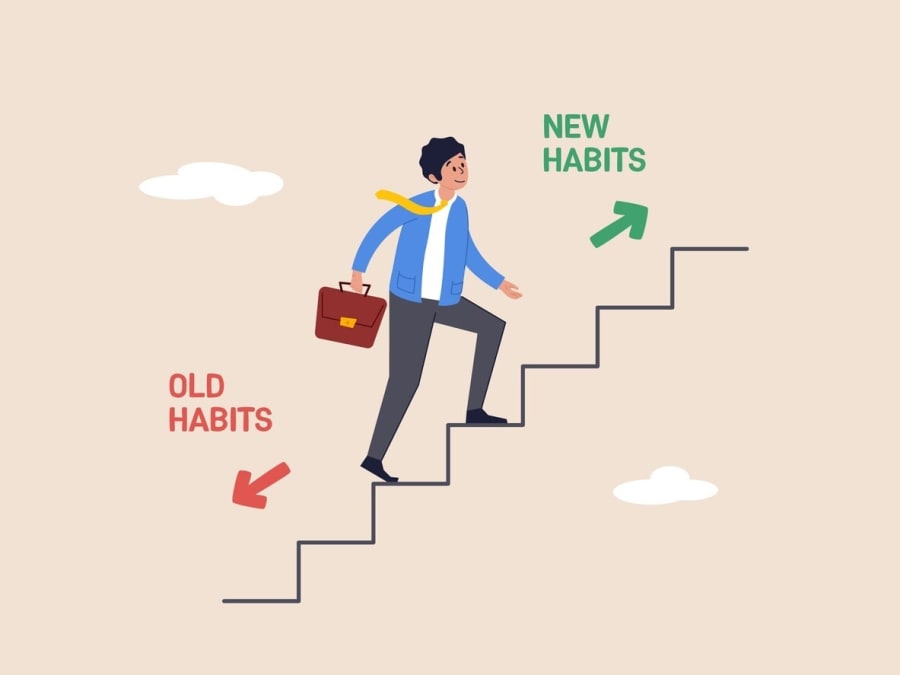Want to build better habits without overhauling your life? Habit stacking helps you effortlessly link new behaviors to routines you already do, making lasting change feel almost automatic. Learn how this simple yet powerful method works, why it’s so effective, and how to start stacking your way to success today.
Key Takeaways
- Habit stacking links new behaviors to existing habits to simplify habit formation and enhance consistency.
- Tracking progress and setting specific cues are essential for successfully integrating new habits into your daily routine.
- Incorporating rewards and enjoyable activities with necessary tasks can bolster motivation and help sustain new habits long-term.
Understanding Habit Stacking

Habit stacking, a concept first outlined by S. J. Scott, is about linking a new habit to an existing one to reinforce memory and reduce mental effort. This method transforms the daunting task of adopting new behaviors into a more manageable process. Leveraging your existing habits, the term habit stacking simplifies the process of adopting new habits.
Habit stacking fundamentally works by linking new habits with automatic daily rituals. For example, if you already have the habit of brushing your teeth every morning, you can stack a new habit, such as flossing, right after it. This creates a seamless transition and reduces the mental effort required to remember and perform the new habit.
The habit stacking formula, “Every time I do X, I will then do Y,” helps integrate new behaviors into your daily routine. This approach helps form new neural connections and ensures new habits feel more integrated and less like an add-on.
One of the significant benefits of habit stacking is that it enhances productivity and fosters healthy habits by combining small, manageable tasks into daily routines. For instance, you might decide to listen to a podcast while washing dishes, thereby pairing a task you need to do with something you enjoy. This makes the process of adopting new habits more enjoyable and sustainable.
The Science Behind Habit Stacking

Understanding the science behind habit stacking provides deeper insights into why this method is so effective. One critical process involved is synaptic pruning, where the brain eliminates less-used synaptic connections between neurons and strengthens frequently used ones. This process is essential for developing new habits, as it makes the brain more efficient at performing habitual actions.
As you practice certain skills or behaviors, your brain reinforces the neural pathways associated with those skills, enhancing performance. This means that the more you repeat a habit, the stronger the neural connections become, making the behavior more automatic over time. By linking a new habit to an existing one, you take advantage of these well-established neural pathways, making it more likely that you’ll maintain the new behavior.
Effective habit stacking utilizes existing daily routines as cues to trigger new behaviors, creating a chain of actions where one naturally leads to the next. This method enhances consistency and makes it easier to integrate new habits into your life. For example, if you stack a new habit like meditation onto your morning coffee routine, the act of making coffee becomes a trigger for meditation, reinforcing the new behavior each day.
How to Start Habit Stacking
Starting habit stacking begins with creating a comprehensive list of your daily habits. Observe and take notes on your existing habits and daily occurrences to identify potential triggers for new habits. This step is crucial because it helps you understand your current routine and where you can seamlessly integrate new behaviors.
Next, brainstorm your current habits and identify specific cues that can serve as triggers for your new habits. Create a list with two columns: one for current habits and the other for daily occurrences. This structured approach allows you to pinpoint the best opportunities for stacking new habits. For instance, if you notice that you always have a cup of coffee in the morning, you can use this as a cue to perform a new habit, such as meditating or writing a daily journal entry.
When starting habit stacking, set specific and achievable goals for your new habits. The structure for habit stacking can be summarized as: After/Before [CURRENT HABIT], I will [NEW HABIT]. Being specific about your new habits increases the likelihood of follow-through and ensures that you have a clear implementation plan.
It’s also important to choose realistic goals based on the time and energy you have available. Avoid vague cues, as they can lead to inconsistent habit performance. Instead, establish highly specific and immediately actionable ideas, such as “After I brush your teeth, I will floss.” This specificity helps to create an effective strategy for integrating new habits into your daily routine through manageable steps.
Effective Strategies for Successful Habit Stacking

To ensure successful habit stacking, it’s important to avoid attempting significant changes too quickly, as this can lead to burnout and the subsequent dropping of habits. Instead, focus on creating larger stacks by chaining small habits together, leveraging the momentum of one action leading to another. For example, you might stack making your bed with a morning ritual like stretching, creating a more organized and energized start to your day through habit stacks.
Pairing enjoyable activities with necessary important tasks can help maintain motivation and make the process more enjoyable. For instance, listening to a podcast while washing dishes can transform a mundane task into an enjoyable experience, reinforcing the habit. Additionally, incorporating a quick yoga session during your lunch break can enhance your overall productivity and well-being, making it easier to tackle your to-do list and the three most important tasks.
Specific and regular cues are crucial for effective habit stacking. Choosing highly specific cues for your new habits enhances the probability of noticing when to act and reduces ambiguity. Ensure that the frequency of your new habit aligns with that of the existing habit it is stacked with, as this consistency is key to successful habit formation.
Habit Stacking Examples

Examples in morning routines, workday integration, and evening wind-downs illustrate how habit stacking works in daily life and how intention positively impacts our lives, following the two-minute rule. Additionally, the idea of habit stacking can enhance these routines.
These examples show how to combine new habits with existing routines, enhancing consistency and achieving desired behaviors in a new routine, while also addressing old habits.
Morning Routine
Morning routines are especially crucial for enhancing productivity and fostering a positive mindset. A well-structured morning habit stack can set the tone for the rest of the day. You could begin your day with a specific habit stack. For instance, start by waking up, making your bed, placing a book on your pillow, and then taking a shower. This sequence helps you transition smoothly from one task to another, creating a sense of accomplishment early in the day, and encourages you to get out of bed.
Another effective morning habit stack is combining drinking your morning coffee with a meditation session. This not only provides a moment of calm and focus but also integrates a new habit with an existing one, making it easier to maintain. The act of making coffee serves as a trigger for meditation, reinforcing the new behavior each morning.
Incorporating these small habits into your morning routine enhances overall productivity and well-being. Structured morning routines help you start the day on a positive note, setting you up for success in your daily tasks and long-term goals as the sun rises.
Workday Integration
Integrating habit stacking into your workday can enhance productivity and make your daily routine more efficient. One useful habit stack is to get dressed for the day and lay out your workout clothes and running shoes, preparing you for exercise later in the day. This small preparation step ensures that you are ready for your workout, making it more likely that you’ll follow through with it.
Another effective workday habit stack is to call a friend during a break or between work meetings. Pairing enjoyable activities with work tasks can help maintain motivation and provide a mental break, enhancing your overall well-being. When you eat lunch, it can also serve as a moment to recharge.
Additionally, integrating physical activity and more exercise into work breaks, such as a quick stretch or walk, can boost energy levels and productivity.
Evening Wind-Down
Creating a relaxing evening routine can help signal to your brain that it’s time to wind down for the day. One simple and effective evening habit stack is to get in bed and turn on sleep meditation.
This combination promotes relaxation and prepares your mind for a restful night’s sleep, enhancing your overall well-being.
Tracking Your Progress

Tracking your progress is essential in habit stacking, as it helps maintain motivation and consistency. By keeping a record of your daily habits, you can identify patterns, recognize areas for improvement, and celebrate your successes. Methods for tracking progress can include using digital tools or a Habits Scorecard for visualization and assessment.
Consistent monitoring of your habits can lead to increased self-awareness and better time management, ultimately supporting the formation of lasting habits. Keeping a journal or using a habit-tracking app lets you see your progress over time and make necessary adjustments. This practice not only helps you stay accountable but also provides valuable insights into your behavior and routine.
Tracking your progress also creates a sense of accomplishment and reinforces your commitment to personal development. Research shows regularly reviewing and adjusting your habits helps create accountability and ensures you stay on track and continue progressing toward your goals.
Rewarding Yourself
Rewards play a crucial role in maintaining new habits by creating positive reinforcement loops. When you associate a new habit with a reward, it satisfies the cravings that drive behavior, enhancing your motivation to stick with the habit.
For example, consistently walking every morning could be rewarded with new workout clothes, providing a tangible incentive to maintain the habit.
It’s important to choose rewards that truly satisfy and motivate you. If the enjoyable aspect of a paired habit fades, it can lead to decreased motivation and difficulty in maintaining the habit. Therefore, regularly updating your rewards and ensuring they remain meaningful can help reinforce your commitment to your new, healthy habits.
Common Pitfalls and How to Avoid Them
Changing existing habits or introducing new ones is inherently challenging. One common pitfall is setting vague cues, which can lead to inconsistent habit performance. To avoid this, it’s crucial to set a specific cue that signals when to perform the new habit. This specificity reduces ambiguity and increases the likelihood of successfully forming the habit.
Boredom is another common issue that can lead to abandoning a habit, especially if it feels repetitive or lacks excitement. If you find yourself dropping off from a new habit after a few days, reflect on why it happened, modify the goal, or choose a different old habit to link to. Making these adjustments keeps your habits engaging and maintains your commitment to personal development.
Summary
Habit stacking is a powerful strategy for building better routines by linking new behaviors to existing ones. By leveraging well-established habits, you can seamlessly integrate new habits into your daily life, reducing mental effort and enhancing productivity. Understanding the science behind habit stacking, setting specific cues, and maintaining realistic goals is crucial for successful implementation.
Whether you’re looking to boost productivity, foster healthy habits, or streamline your daily tasks, habit stacking offers a practical and effective approach. Start small, track your progress, reward yourself, and make adjustments as needed. With these strategies, you can create lasting positive changes and achieve your personal development goals.
Frequently Asked Questions
Habit stacking is an effective strategy that connects a new habit to an existing one, making it easier to adopt by reinforcing memory and minimizing mental effort. This approach helps facilitate the formation of new, sustainable behaviors.
Habit stacking effectively combines new habits with existing routines, making it easier to adopt the new behavior by reducing the mental effort required to remember it. This method encourages a smooth transition into incorporating positive changes into your daily life.
Using specific cues in habit stacking is essential as they eliminate ambiguity and significantly enhance the chances of successfully establishing a new habit. Clear cues guide your actions, ensuring you perform the habit consistently.
To successfully stack habits, begin with small, attainable goals and connect enjoyable activities with necessary tasks. This approach helps maintain your motivation and increases the likelihood of incorporating new habits into your routine.
To effectively track your progress in habit stacking, use digital tools or a Habits Scorecard for visualization and assessment. This consistent monitoring not only boosts motivation but also enhances self-awareness, aiding in the formation of lasting habits.





